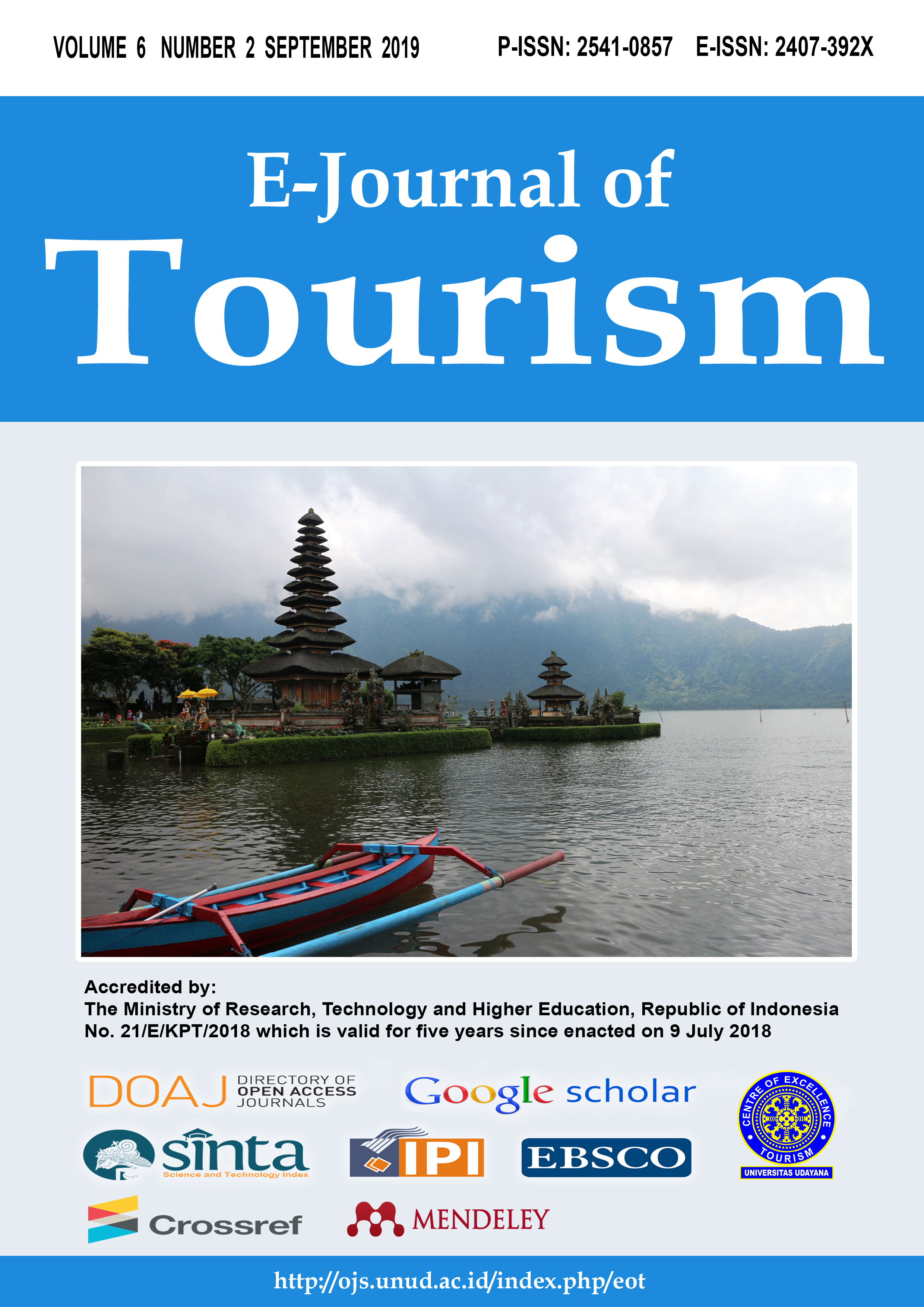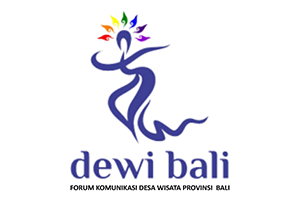Improving Tourism Destination Management Through Sustainable Tourism Development Model A Case Study on TSR
Abstract
As a priority destination, Lake Toba area should immediately clean up so as not to lag behind compared to other destinations. One important indicator of the good governance of tourism in this priority destination is, when the destination has run the management and development of tourism/destination with the principles of Sustainable Tourism Development (STD). According to Global Sustainable Tourism Council (GSTC) the principles that must be met, among others are; 1) demonstrating effective sustainable management, 2) maximizing social and economic benefit to the local community and minimizing negative impacts; 3) maximizing benefit to cultural heritage and minimizing negative impacts; and 4) maximize benefit to the environtment and minimizing negative impacts in accordance with Permenpar No .14 / 2016. Given the importance of STD implementation in the Lake Toba area, this research tries to assess and influence one of the important destinations in Lake Toba area, namely Taman Simalem Resort (TSR) located right on the edge of Lake Toba, Merek Sub District, Karo District. It is expected that by encouraging TSR in applying STD, TSR can become a local champion and become model of STD application in Toba Lake Area.
Downloads
References
Akama, J. S. dan Kieti, D. (2007) “Tourism and Socio-economic Development in Developing Countries: A Case Study of Mombasa Resort in Kenya,” Journal of Sustainable Tourism, 15(6), hal. 735–748. doi: 10.2167/jost543.0.
Alex (2017) Taman Simalem Resort Juara II ISTA, Harian Analisa. Tersedia pada: http://harian.analisadaily.com/sumut/news/taman-simalem-resort-juara-ii-ista/423870/2017/09/30 (Diakses: 14 Juli 2018).
Amerta, I. M. S., Sara, I. M. dan Bagiada, K. (2018) “Sustainable Tourism Development,” International Research Journal of Management, IT and Social Sciences (IRJMIS), 5(2), hal. 248–254. Tersedia pada: https://ijcujournals.us/journals/index.php/irjmis/article/view/176.
Bassi, A. dan Sheng, F. (2012) Measuring Progress Towards an Inclusive Green Economy. Nairobi: United Nations Environment Programme (UNEP), United Nations Environment programme (UNEP). Nairobi.
Blancas, F. J. et al. (2010) “The assessment of sustainable tourism: Application to Spanish coastal destinations,” Ecological Indicators, 10(2), hal. 484–492. doi: 10.1016/j.ecolind.2009.08.001.
Butler, R. W. (1999) “Sustainable tourism: A state‐of‐the‐art review,” Tourism Geographies, 1(1), hal. 7–25. doi: 10.1080/14616689908721291.
Castellani, V. dan Sala, S. (2010) “Sustainable performance index for tourism policy development,” Tourism Management. Elsevier Ltd, 31(6), hal. 871–880. doi: 10.1016/j.tourman.2009.10.001.
Dergibson dan Siagian, S. (2006) Metode Statistika untuk Bisnis dan Ekonomi.
Dewipule (2015) Pulesari Menjadi Pilot Project, 20 Destinasi di Indonesia, Wordpress. Tersedia pada: https://desawisatapulesari.wordpress.com/2016/02/01/pulesari-menjadi-pilot-project-proiritas-20-destinasi-di-indonesia/ (Diakses: 6 Juli 2018).
Fennell, D. A. (2014) Ecotourism. 4 ed. Routledge. Tersedia pada: https://books.google.co.id/books?hl=id&lr=&id=oYmbBAAAQBAJ&oi=fnd&pg=PP1&ots=geUzOG5MHP&sig=DZbSupAQJzE9J5ENhyuXqOEE6w4&redir_esc=y#v=onepage&q&f=false (Diakses: 6 Juli 2018).
GSTC (2017) GSTC Criteria - Global Sustainable Tourism Council (GSTC). Tersedia pada: https://www.gstcouncil.org/gstc-criteria/ (Diakses: 30 November 2017).
Hák, T., Janoušková, S. dan Moldan, B. (2016) “Sustainable Development Goals: A need for relevant indicators,” Ecological Indicators, 60, hal. 565–573. doi: 10.1016/j.ecolind.2015.08.003.
Hardy, A., Beeton, R. J. S. dan Pearson, L. (2002) “Sustainable tourism: An overview of the concept and its position in relation to conceptualisations of tourism,” Journal of Sustainable Tourism, 10(6), hal. 475–496. doi: 10.1080/09669580208667183.
Heinen, J. T. (1994) “Emerging, diverging and converging paradigms on sustainable development,” International Journal of Sustainable Development and World Ecology, 1(1), hal. 22–33. doi: 10.1080/13504509409469857.
Hulme, D. (2009) A Short History of the World ’ s Biggest Promise September 2009 BWPI Working Paper 100.
Hunter, C. J. (1995) “On the Need to Re‐Conceptualise Sustainable Tourism Development,” Journal of Sustainable Tourism. Taylor & Francis Group, 3(3), hal. 155–165. doi: 10.1080/09669589509510720.
Ibo, A. (2015) 10 Destinasi Wisata Prioritas di Tahun 2016, Liputan 6. Tersedia pada: https://www.liputan6.com/lifestyle/read/2401196/10-destinasi-wisata-prioritas-di-tahun-2016 (Diakses: 6 Juli 2018).
Kemenpar (2016) Peraturan Menteri Pariwisata Republik Indonesia No.14 Tahun 2016 Tentang Pedoman Destinasi Pariwiata Bekelanjutan. Tersedia pada: http://kemenpar.go.id/asp/detil.asp?c=38&id=3290 (Diakses: 30 November 2017).
Kominfo (2016) 10 Destinasi Pariwisata Prioritas 2016, Kementerian Komunikasi dan Informatika Republik Indonesia. Tersedia pada: https://kominfo.go.id/index.php/content/detail/7513/10-destinasi-pariwisata-prioritas-2016/0/infografis (Diakses: 6 Juli 2018).
Kristjánsdóttir, K. R., Ólafsdóttir, R. dan Ragnarsdóttir, K. V. (2018) “Reviewing Integrated Sustainability Indicators for Tourism,” Journal of Sustainable Tourism. Routledge, 26(4), hal. 583–599. doi: 10.1080/09669582.2017.1364741.
Kumar, A. et al. (2017) “A Review of Multi Criteria Decision Making (MCDM) Towards Sustainable Renewable Energy Development,” Renewable and Sustainable Energy Reviews. Pergamon, 69, hal. 596–609. doi: 10.1016/J.RSER.2016.11.191.
Lane, B. (1994) “Sustainable rural tourism strategies: A tool for development and conservation,” Journal of Sustainable Tourism, 2(1–2), hal. 102–111. doi: 10.1080/09669589409510687.
Law, A., DeLacy, T. dan McGrath, G. M. (2017) “A Green Economy Indicator Framework for Tourism Destinations,” Journal of Sustainable Tourism. Taylor & Francis, 25(10), hal. 1434–1455. doi: 10.1080/09669582.2017.1284857.
Lele, S. M. (1991) “Sustainable development: a critical review,” World Development, 19(6), hal. 607–621. doi: 10.1016/0305-750X(91)90197-P.
Liu, Z. (2003) “Sustainable Tourism Development: A Critique,” Journal of Sustainable Tourism. Taylor & Francis Group, 11(6), hal. 459–475. doi: 10.1080/09669580308667216.
Nam, U. (2016) Transforming our world: the 2030 Agenda for Sustainable Development, UNDP Viet Nam Natural Capital Platform. Tersedia pada: http://www.naturalcapital.vn/wp-content/uploads/2017/02/UNDP-Viet-Nam.pdf (Diakses: 30 November 2017).
Nowacki, M. et al. (2018) “Strategic Planning for Sustainable Tourism Development in Poland,” International Journal of Sustainable Development & World Ecology. Taylor & Francis, 25(6), hal. 562–567. doi: 10.1080/13504509.2018.1432513.
Nurhidayati, S. E. (2007) “Community Based Tourism (CBT) sebagai Pendekatan Pembangunan Pariwisata Berkelanjutan,” Jurnal Masyarakat, Kebudayaan, dan Politik Universitas Airlangga, Th XX 3, hal. 191–202. Tersedia pada: http://www.journal.unair.ac.id/filerPDF/Community Based Tourism _CBT_.pdf (Diakses: 14 Juli 2018).
OECD (2014) “Green Growth Indicators 2014.” OECD Green Growth Studies. doi: https://doi.org/10.1787/9789264202030-en.
Ottenbacher, M. C. et al. (2018) “Sustainability Criteria for Tourism Attractions: A Case Study of Germany. In Sustainable Development: Concepts, Methodologies, Tools, and Applications,” in IGI Global, hal. 1526–1548. Tersedia pada: https://www.igi-global.com/chapter/sustainability-criteria-for-tourism-attractions/189957.
Paunović, I. dan Jovanović, V. (2017) “Implementation of Sustainable Tourism in the German Alps: A Case Study,” Sustainability. Multidisciplinary Digital Publishing Institute, 9(2), hal. 226. doi: 10.3390/su9020226.
Peng, K.-H. dan Tzeng, G.-H. (2017) “Exploring Heritage Tourism Performance Improvement for Making Sustainable development strategies using the hybrid-modified MADM model,” Current Issues in Tourism. Routledge, hal. 1–27. doi: 10.1080/13683500.2017.1306030.
Ritchie, J. R. B. dan Crouch, G. I. (2003) The Competitive Destination: A Sustainable Tourism Perspective - J. R. Brent Ritchie, Geoffrey Ian Crouch - Google Buku. Cabi. Tersedia pada: https://books.google.co.id/books?hl=id&lr=&id=yvydAwAAQBAJ&oi=fnd&pg=PR5&dq=Ritchie+dan+Crouch+The+Competitive+Destination+&ots=lRKVbnncYJ&sig=f6Je7Z2BKKYGXlZc4k3Lnx75JZ8&redir_esc=y#v=onepage&q=Ritchie dan Crouch The Competitive Destination&f=f (Diakses: 17 Juli 2018).
Rizkianto, N. dan Topowijono, T. (2018) “Penerapan Konsep Community Based Tourism dalam Pengelolaan Daya Tarik Wisata Berkelanjutan (Studi Pada Desa Wisata Bangun, Kecamatan Munjungan, Kabupaten Trenggalek),” Jurnal Administrasi Bisnis, 58(1). Tersedia pada: http://administrasibisnis.studentjournal.ub.ac.id/index.php/jab/article/view/2402 (Diakses: 14 Juli 2018).
Dos Santos, R. A., Méxas, M. P. dan Meiriño, M. J. (2017) “Sustainability and Hotel Business: Criteria for Holistic, Integrated and Participative Development,” Journal of Cleaner Production. Elsevier, 142, hal. 217–224. doi: 10.1016/J.JCLEPRO.2016.04.098.
Seaford, C. dan Jeffrey, K. (2015) Headline Indicators of Progress for a Green Economy. NETGREEN - Network for Green Economy Indicators - Policiy Brief. Tersedia pada: file:///D:/0008 - P E N E L I T I A N/2017a - tata kelola tsr dengan STD 10j ess/000 - Proposal 2017 STD/NETGREEN_PolicyBrief_HeadlineIndicators2015.pdf.
Singh, M. (2018) “Sustainable development of tourism in Uttarakhand, (India),” International Journal of Academic Research and Development, 3(2), hal. 828–831.
Steer, A. dan Wade-Gery, W. (1993) “Sustainable Development: Theory and Practice for a Sustainable Future,” Sustainable Development. Wiley-Blackwell, 1(3), hal. 23–35. doi: 10.1002/sd.3460010306.
Torres-Delgado, A. dan López Palomeque, F. (2017) “The ISOST index: A tool for studying sustainable tourism,” Journal of Destination Marketing & Management. Elsevier. doi: 10.1016/J.JDMM.2017.05.005.
Tosun, C. (2001) “Challenges of sustainable tourism development in the developing world: The case of Turkey,” Tourism Management, 22(3), hal. 289–303. doi: 10.1016/S0261-5177(00)00060-1.
Tribe, J. (2011) The Economics of Recreation, Leisure and Tourism. Routledge. doi: 10.4324/9780080890517.
UNEP dan UNWTO (2005) Making Tourism More Sustainable - A Guide for Policy Makers, UNWTO. Tersedia pada: http://sdt.unwto.org/content/about-us-5 (Diakses: 17 Juli 2018).
WECD, S. W. S. (1987) “World Commission on Environment and Development - Our Common Future.”
Wysokinska, Z. (2017) “Millenium Development Goals/UN and Sustainable Development Goals/UN as Instruments for Realising Sustainable Concept in the Global Economy,” Comparative Economic Research, 20(1).
Wysokińska, Z. (2017) “Millenium Development Goals/UN and Sustainable Development Goals/UN as Instruments for Realising Sustainable Development Concept in the Global Economy,” Comparative Economic Research. De Gruyter Open, 20(1), hal. 101–118. doi: 10.1515/cer-2017-0006.

This work is licensed under a Creative Commons Attribution 4.0 International License.
The copyright of the received article shall be assigned to the journal as the publisher of the journal. The intended copyright includes the right to publish the article in various forms (including reprints). The journal maintains the publishing rights to the published articles.




















